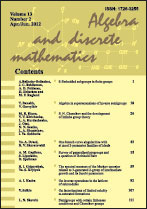|
|
Algebra and Discrete Mathematics, 2008, Issue 1, Pages 1–163
(Mi adm155)
|
|
|
|
This article is cited in 19 scientific papers (total in 19 papers)
RESEARCH ARTICLE
On classification of groups generated by 3-state automata over a 2-letter alphabet
Ievgen Bondarenkoa, Rostislav Grigorchukb, Rostyslav Kravchenkob, Yevgen Muntyanb, Volodymyr Nekrashevychb, Dmytro Savchukb, Zoran Šunícb
a Kyiv Taras Shevchenko University, Ukraine
b Texas A&M University, USA
Abstract:
We show that the class of groups generated by 3-state automata over a 2-letter alphabet has no more than 122 members. For each group in the class we provide some basic information, such as short relators, a few initial values of the growth function, a few initial values of the sizes of the quotients by level stabilizers (congruence quotients), and hystogram of the spectrum of the adjacency operator of the Schreier graph of the action on level 9. In most cases we provide more information, such as whether the group is contracting, self-replicating, or (weakly) branch group, and exhibit elements of infinite order (we show that no group in the class is an infinite torsion group). A GAP package, written by Muntyan and Savchuk, was used to perform some necessary calculations. For some of the examples, we establish that they are (virtually) iterated monodromy groups of post-critically finite rational functions, in which cases we describe the functions and the limit spaces. There are exactly 6 finite groups in the class (of order no greater than 16), two free abelian groups (of rank 1 and 2), and only one free nonabelian group (of rank 3). The other examples in the class range from familiar (some virtually abelian groups, lamplighter group, Baumslag–Solitar groups $BS(1,\pm3)$, and a free product $C_2\ast C_2\ast C_2$) to enticing (Basilica group and a few other iterated monodromy groups).
Keywords:
automata groups, self-similar groups, branch groups.
Received: 18.12.2007
Revised: 15.02.2007
Citation:
Ievgen Bondarenko, Rostislav Grigorchuk, Rostyslav Kravchenko, Yevgen Muntyan, Volodymyr Nekrashevych, Dmytro Savchuk, Zoran Šuníc, “On classification of groups generated by 3-state automata over a 2-letter alphabet”, Algebra Discrete Math., 2008, no. 1, 1–163
Linking options:
https://www.mathnet.ru/eng/adm155 https://www.mathnet.ru/eng/adm/y2008/i1/p1
|

| Statistics & downloads: |
| Abstract page: | 413 | | Full-text PDF : | 307 | | First page: | 1 |
|




 Contact us:
Contact us: Terms of Use
Terms of Use
 Registration to the website
Registration to the website Logotypes
Logotypes






 Citation in format
Citation in format 
